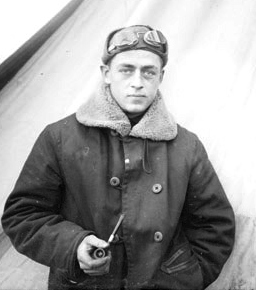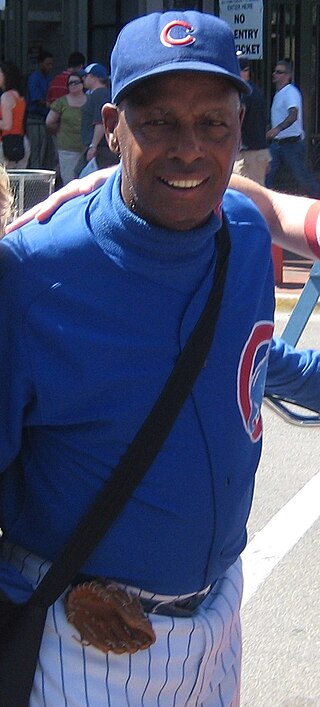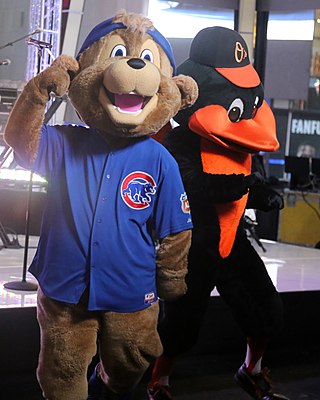
Jerry Pritikin is a lifelong Chicago Cubs fan known as the Bleacher Preacher.

Jerry Pritikin is a lifelong Chicago Cubs fan known as the Bleacher Preacher.
Pritikin became a Cubs fan in 1945 at the age of eight, when the Cubs were in the World Series and he begged his father to take him to a game. While denying his request, his father did promise to take him the next time the Cubs made it to the Series (a feat the Cubs would not achieve until 2016). [1] Pritikin started going to Cubs games with his brothers and sisters. In 1960 he moved to San Francisco, where he worked as a photographer, selling his photos to wire services and local newspapers. [1] He started attending baseball games at Candlestick Park, where he gained notoriety as a Cubs fan. In 1981, he became a paid consultant for a production of Bleacher Bums , coaching the cast on how Chicago Cubs fans acted. [1]
Pritikin moved back to Chicago in 1985 and began to regularly attend Cubs games at Wrigley Field. He admired the Cubs fan known as "Slow Motion Happy" in the mid-40s and decided to put together his own character, which was later called the "Bleacher Preacher". The Bleacher Preacher became famous around Chicago for his routine. [2]
During Cubs games at the "Friendly Confines," Pritikin sat in the bleachers [3] and attempted to convert fans of opposing teams as the "Bleacher Preacher". [4]
As the Bleacher Preacher, Pritikin wore a solar-powered propeller pith helmet. He carried around a life-sized voodoo doll dressed in the uniforms of various visiting teams. Pritikin also carried "The Ten Cub-Mandments", a sign fashioned after the Ten Commandments.
In 2014, Pritikin was named the recipient of the Hilda Award, given by the Baseball Reliquary in Pasadena, Ca. The award was named after Hilda Chester, the fabled fan of the Brooklyn Dodgers, known for her cowbell. The award is given to fans who have contributed to the game of baseball.
Pritikin is largely the subject of the Lonnie Wheeler book Bleachers. Edgar Lenze interviewed Pritikin for his documentary about Chicago Cubs fans entitled Keep the Faith. [4] During the 1980 his name and likeness often appeared in newspapers. Broadcaster Harry Caray once called Pritikin "the world's greatest Cubs fan". [1]

The Chicago Cubs are an American professional baseball team based in Chicago. The Cubs compete in Major League Baseball (MLB) as part of the National League (NL) Central Division. The club plays its home games at Wrigley Field, which is located on Chicago's North Side. They are one of two major league teams based in Chicago, alongside the American League (AL)’s Chicago White Sox. The Cubs, first known as the White Stockings, were a founding member of the NL in 1876, becoming the Chicago Cubs in 1903.

Wrigley Field is a baseball stadium on the North Side of Chicago, Illinois. It is the ballpark of Major League Baseball's Chicago Cubs, one of the city's two MLB franchises. It first opened in 1914 as Weeghman Park for Charles Weeghman's Chicago Whales of the Federal League, which folded after the 1915 baseball season. The Cubs played their first home game at the park on April 20, 1916, defeating the Cincinnati Reds 7–6 in 11 innings. Chewing gum magnate William Wrigley Jr. of the Wrigley Company acquired the Cubs in 1921. It was named Cubs Park from 1920 to 1926, before being renamed Wrigley Field in 1927. The stadium currently seats 41,649 people and is the second stadium to be named Wrigley Field, as a Los Angeles ballpark with the same name opened in 1925.

Ronald Edward Santo was an American Major League Baseball (MLB) third baseman who played for the Chicago Cubs from 1960 through 1973 and the Chicago White Sox in 1974. In 1990, Santo became a member of the Cubs broadcasting team providing commentary for Cubs games on WGN radio and remained at that position until his death in 2010. In 1999, he was selected to the Cubs All-Century Team. He was inducted into the National Baseball Hall of Fame in 2012.

The Cubs–White Sox rivalry refers to the Major League Baseball (MLB) geographical rivalry between the Chicago Cubs and Chicago White Sox. The Cubs are a member club of MLB's National League (NL) Central division, and play their home games at Wrigley Field, located on Chicago's North Side. The White Sox are a member club of MLB's American League (AL) Central division, and play their home games at Guaranteed Rate Field, located on Chicago's South Side.

West Side Park was the name used for two different ballparks that formerly stood in Chicago, Illinois. They were both home fields of the team now known as the Chicago Cubs of the National League. Both ballparks hosted baseball championships. The latter of the two parks, where the franchise played for nearly a quarter century, was the home of the first two world champion Cubs teams, the team that posted the best winning percentage in Major League Baseball history and won the most games in National League history (1906), the only cross-town World Series in Chicago (1906), and the immortalized Tinker to Evers to Chance double-play combo. Both ballparks were primarily constructed of wood.

Philip Knight Wrigley was an American chewing gum manufacturer and a Major League Baseball executive, inheriting both of those roles as the quiet son of his much more flamboyant father, William Wrigley Jr.
The Brewers–Cubs rivalry is a Major League Baseball (MLB) rivalry between the Milwaukee Brewers and Chicago Cubs. Both clubs are members of MLB's National League (NL) Central Division. The rivalry is also sometimes known as the I-94 Rivalry, because the two teams' ballparks are located only 83 miles (134 km) from each other off Interstate 94 (I-94).
Bleacher Bums is a 1977 play written collaboratively by members of Chicago's Organic Theater Company, from an idea by actor Joe Mantegna. Its original Chicago production was directed by Stuart Gordon. A 1979 performance of the play was taped for PBS television, and in 2002 a made-for-TV movie adaptation was produced.

Ronnie "Woo Woo" Wickers is a longtime Chicago Cubs fan and local celebrity in the Chicago area. He is known to Wrigley Field visitors for his idiosyncratic cheers at baseball games, generally punctuated with an exclamatory "Woo!" Longtime Cubs announcer Harry Caray dubbed Wickers "Leather Lungs" for his ability to shout for hours at a time.

The following is a franchise history of the Chicago Cubs of Major League Baseball, a charter member of the National League who started play in the National Association in 1870 as the Chicago White Stockings. The Chicago National League Ball Club is the only franchise to play continuously in the same city since the formation of the National League in 1876. They are the earliest formed active professional sports club in North America, predating the team now known as the Atlanta Braves by one year. In their early history, they were called in the press the White Stockings, Orphans, Infants, Remnants and Colts before officially becoming "Cubs" in 1907.

The 1984 Chicago Cubs season was the 113th season of the Chicago Cubs franchise, the 109th in the National League and the 69th at Wrigley Field. The Cubs finished with a record of 96 wins and 65 losses in first place of the National League East. Chicago was managed by Jim Frey and the general manager was Dallas Green. The Cubs' postseason appearance in this season was their first since 1945. The Cubs pitching staff included 1984 Cy Young Award winner Rick Sutcliffe, and the lineup included 1984 Baseball Most Valuable Player Award winner second baseman Ryne Sandberg. Frey was awarded Manager of the Year for the National League for leading the Cubs to 96 victories. The Cubs were defeated in the 1984 National League Championship Series by the San Diego Padres three games to two.
The 1938 Chicago Cubs season was the 67th season of the Chicago Cubs franchise, the 63rd in the National League and the 23rd at Wrigley Field. The Cubs finished first in the National League with a record of 89–63. The team was swept four games to none by the New York Yankees in the World Series.
The Homer in the Gloamin' is one of the most famous home runs in baseball folklore, hit by Gabby Hartnett of the Chicago Cubs near the end of the 1938 Major League Baseball season. A play on the popular song "Roamin' in the Gloamin'", the phrase was written by Associated Press reporter Earl Hilligan in a story about the game.
The history of Wrigley Field, the home of the Chicago Cubs of Major League Baseball's National League, begins well before the Cubs played their first game in that venue.

Clark is the official team mascot of Major League Baseball's Chicago Cubs. He was announced on January 13, 2014, as the first official mascot in the modern history of the Cubs franchise. He was introduced that day at the Advocate Illinois Masonic Medical Center's pediatric developmental center along with some of the Cubs' top prospects such as number one draft pick Kris Bryant and Albert Almora, Jorge Soler, Mike Olt and Eric Jokisch. Over a dozen Cubs prospects were attending the Cubs' Rookie Development Program that week. The Cubs become the 27th team in Major League Baseball to have a mascot, leaving the Los Angeles Angels, Los Angeles Dodgers and New York Yankees as the remaining franchises without mascots. According to the Cubs' press release, Clark is a response to fan demands for more kid-friendly elements at Wrigley Field Cubs games to keep pace with games in other cities that have more to offer youth fans.

The 2015 Chicago Cubs season was the 144th season for the franchise, the 140th in the National League and the 100th at Wrigley Field. The Cubs were managed by Joe Maddon in his first year as Cubs manager and played their home games at Wrigley Field as members of the National League Central.
Since purchasing the Chicago Cubs baseball team and Wrigley Field in 2009, the Ricketts family have been pursuing an extensive renovation of the stadium and the surrounding venue. At its outset, the 1060 Project was projected to cost $575 million and was to be completed in four phases during consecutive off-seasons. Funding was generated from advertising revenue and increased corporate sponsorship in the form of additional signage placed in and around the stadium.

"A Dying Cub Fan's Last Request" is a folk song written by Steve Goodman in 1981 and first performed by him on a WGN radio show that year. The song tells the story of a Chicago Cubs fan looking back at decades of supporting the struggling baseball team. Goodman wrote the song in the spring of 1981, just before that year's Major League Baseball strike interrupted the season. Goodman, a native of Chicago, incorporated a number of specific references to the city, the Cubs, and their baseball stadium, Wrigley Field.
On June 23, 1984, the Chicago Cubs took on the St. Louis Cardinals in a Major League Baseball contest that saw Willie McGee hit for the cycle, but Ryne Sandberg hit two home runs—in the ninth and tenth innings—to propel the Cubs to a 12–11 victory. The Cubs overcame deficits of 7–1, 9–3, and 11–9 as Sandberg hit a pair of game-tying home runs in late-inning action, both off ex-Cubs ace Bruce Sutter. NBC play-by-play announcer Bob Costas, who called the game with Tony Kubek, is remembered for saying "Do you believe it?!" when Sandberg hit the second home run. The game is known as The Sandberg Game.